Foteviken Museum
The Foteviken Museum (Swedish: Fotevikens Museum) is an archaeological open-air museum on the Höllviken peninsula in southern Skåne, Sweden. It contains a reconstruction of a large Viking Age settlement and a "viking reservation", and visitors participate in living history reenactments; it also performs research and functions as the municipal museum of Vellinge Municipality and part of Fotevikens Kulturcenter, a group of cultural facilities on the peninsula.
Fotevikens Museum | |
| Established | 1995 |
|---|---|
| Location | Höllviken, Skåne, Sweden |
| Coordinates | 55°25′45.41″N 12°57′11.3″E |
| Type | open-air museum |
| Website | www |
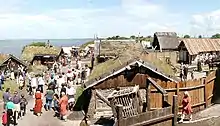
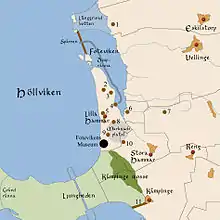
History
The museum grew out of the archaeological investigation of sunken viking ships in Foteviken Bay and local interest in the Battle of Fotevik, which was fought there on 4 June 1134. A group headed by Björn M. Buttler Jakobsen formed a foundation called SVEG (Scandinavian Viking Explorer Group) in 1987. In 1993, the foundation started planning to open a maritime museum;[1] in 1995, after changing their focus towards Viking Age living history, they opened Foteviken Museum, with Jakobsen as its director.[2][3] At the Cog Museum in Malmö, the group built two replica viking cogs; in 2014 the city sold these and the harbour site where they are located is now a medieval-themed tourist area called Medeltidsriket Malmöya.[2]
Facilities and programmes
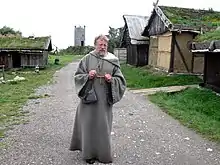
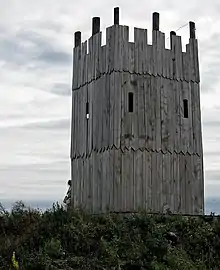
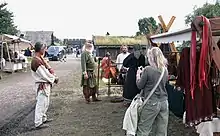
The museum occupies an approximately 70,000-square-metre (17-acre) site on Höllviken Bay. In addition to a reconstruction of a large Viking Age settlement, the 'Viking Reserve', there are research and handicrafts buildings and three large halls, including a restaurant seating up to 200 and a feast hall. The gate to the reserve is indicated on the museum map as a "border gate" between Sweden and the reserve.[4] Buildings in the reserve are built or rebuilt by staff and volunteers almost every season, with traditional methods being supplemented by modern technology in winter;[5] as of 2010 there were about 22, including a tapestry-lined chieftain's house[6] and a hof.[7] The reserve opens for the summer season on May Day,[3] and is intended as a recreation of a large settlement late in the Viking Age, during the transition to the Scandinavian Middle Ages and the increasing influence of Christianity in the North.[8] This enables the museum to include the Battle of Fotevik, which clearly belongs to the medieval period.[9] Those staying in the reserve live as Viking Age people[6] and are not permitted to have modern equipment or wear modern clothing.[10] It is marketed as open to "all Vikings"[11] and attracts large numbers of Viking Age reenactors;[2][7] many of the visitors are from outside Scandinavia, particularly from Germany.[12] An international viking thing is held in the Tinghöll building every year; according to the museum, in 2001 66 representatives from 22 countries were present.[9]
The museum has a library which is available for research and makes heavy use of electronic media.[8] It offers various educational programmes, including overnight stays; since it is also the municipal museum of Vellinge, these are free to local schools.[13] However, the reserve has no electricity and minimal signage.[8]
Seasonal programmes
In Midwinter the museum hosts a fire festival.[14] A May Eve bonfire is also lit to reproduce a traditional viking celebration of the return of spring.[15] At these and other events, the director plays the role of 'King Björn'.[3]
Summer activities at the museum climax in Viking Week in late June;[2] this includes craft days[10] and since 1997 a viking market.[9] At the market in summer 2016, five actors in a group who travel between Viking Age reenactment sites, the Nordic International Slave Trade Company, reportedly threw a bag over a tourist's head and auctioned her off as a thrall.[16][17] The police have said they will be speaking to people at the museum about treatment of members of the public.[18]
Gallery










 Fetching water in the viking village.
Fetching water in the viking village. Wall tapestry in a house in the viking village.
Wall tapestry in a house in the viking village.
See also
References
- Roeland Paardekooper, The Value of an Archaeological Open-Air Museum Is in Its Use: Understanding Archaeological Open-Air Museums and Their Visitors, Leiden: Sidestone, 2012, ISBN 9789088901034, p. 189.
- Jan Samuelsson, "Leva som en viking lockar", Sydsvenskan, 16 March 2015 (in Swedish).
- Elin Wrethov, "Vikingakung trivs när han får berätta", Sydsvenskan, 29 April 2015 (in Swedish).
- Paardekooper, pp. 189, 191–92.
- Paardekooper, pp. 193–94.
- Becky Ohlsen and Cristian Bonetto, Sweden, 4th ed. Footscray, Victoria / London: Lonely Planet, 2009, ISBN 9781741047752, e-book 2010, p. 183.
- James Proctor and Neil Roland, Sweden, 3rd ed. London: Rough Guides, 2003, ISBN 9781843530664, p. 248.
- Paardekooper, pp. 195–96.
- Bodil Petersson, Föreställningar om det förflutna: Arkeologi och rekonstruktion, Lund: Nordic Academic Press, 2003, ISBN 9789189116481 (in Swedish).
- Mats Amnell, "Så används en völvestav!", Sydsvenskan, 28 June 2016 (in Swedish).
- Birgitta Svensson, "The Power of Cultural Heritage Tourism: Relations Between Culture and Nature in Historical Landscapes", in Alf Hornborg and Gisli Pálsson, ed., Negotiating Nature: Culture, Power, and Environmental Argument, Lund Studies in Human Ecology 2, Lund: Lund University, 2000, OCLC 53154446, p. 45.
- Paardekooper, pp. 196–97.
- Paardekooper, p. 191.
- Elin Wrethov, "Dags för den årliga eldfesten hos vikingarna", Sydsvenskan, 10 December 2014 (in Swedish).
- Gunilla Fritze, "Kung Björn: Våren är här!" SVT, 30 April 2015 (in Swedish).
- "Museibesökare såldes som slav", Folkbladet, 13 July 2016 (in Swedish).
- "Swedish museum accused of selling woman as Viking slave", The Local (Sweden), 13 July 2016.
- Micaela Landelius, "'De måste ta det lugnt med folk'", Sydsvenskan, 15 July 2016 (in Swedish).
Further reading
- Sven Rosborn. Fotevikens museum: Platsen där drömmar blir till verklighet. Utgiven i samband med Fotevikens museums 10 årsjubileum 2005. [Höllviken : Fotevikens museum], 2005. ISBN 9789197377720. Pdf at Academia.edu; registration required. (in Swedish)
External links
 Media related to Fotevikens Museum at Wikimedia Commons
Media related to Fotevikens Museum at Wikimedia Commons- Foteviken Museum